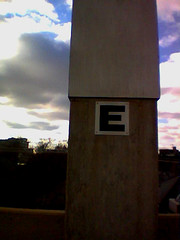I probably don’t have to tell you that The Pokey Little Puppy is a Little Golden Book. This edition had an illustration on the back with all of the characters from all of the Little Golden Books doing all kinds of clever things as they more or less danced their way through the letters of the alphabet, which bordered the back cover. For all I know they’re still printing them this way.
I asked her what the letters were, and from there a conversation unfolded that made my five-year old mind explode.
I learned that they were the letters of the alphabet, and that there were 26 of them. (This was a number I could understand: I had counted to 50 for the first time not long before that.) I learned that they were not only THE letters of the alphabet; they were ALL the letters of the alphabet. And I learned that every single word inside the book we had just read had been made up of different combinations of these very same letters.
I didn’t believe her: No way could all those different words be made up of only these few letters. So I took the book outside (we were hippies: this was allowed) and started to hunt through it – trying to find a new letter; one that didn't make it to the back of the book.
Never found it.
So knowing now that I’m easily amazed, as well as a little bit of a hippy-naturalist-type, maybe you’ll forgive me for thinking this next piece is one of the most interesting things I’ve read in a while. A group of folks at the California Institute of Technology think they've figured out what all of the world's alphabets share in common -- and it's topographical:
The team set out to explore the idea that the visual signs we use [including alphabetic forms] have been selected, whatever the culture, to reflect common contours, landscapes and shapes in natural scenes that human brains have evolved to be good at seeing.*** Across 115 writing systems to emerge over human history, varying in number of characters from about 10 to 200, the average number of strokes per character is approximately three and does not appear to vary as a function of writing system size. Sticking to letters that can be drawn with three strokes or fewer, the team found that about 36 distinct characters is the universe of letters in a theoretical alphabet.
Remarkably, the study revealed regularities in the distribution of (topological) shapes across approximately 100 phonemic (non-logographic) writing systems, where characters stand for sounds, and across symbols. "Whether you use Chinese or physics symbols, the shapes that are common in one are common in the others," said Dr Changizi.*** They analysed the frequency of the shapes in 27 photographs of savannas and tribal life, 40 miscellaneous photographs of rural and small-town life and 40 computer-generated images of buildings. Much to their surprise, whether analysing the shapes in an urban landscape, or those in a leafy wilderness, they had very similar distributions of configurations and shapes.
Most striking of all, the team found a high correlation between the most common contour combinations found in nature and the most common contours found in letters and symbols across cultures. For example, contours resembling an "L" or "X" are more common in both human visual signs and natural scenes than anything resembling an asterisk (*).
When the popularity of each shape was plotted, a wiggly curve emerged that closely matched that of the popularity of the forms and architectures found in nature: the most common letter shapes mirrored common real-world shapes.
If you didn't catch all that (and I'm not sure I have, yet), you can read the whole write up online at The Telegraph, or you can wait until the CalTech team publishes their paper next month in the American Naturalist.







2 comments:
Brain...exploding...
OK, I'll have to reread this later in the day when I'm fully functional.
Very interesting....
BUT
you gave a shout-out to "the pokey little puppy"!!!!!
FAVE.BOOK.EVER! That was the book I BEGGED to have read to me every night!
Post a Comment